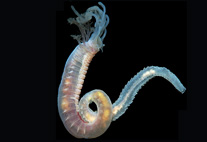Abstract
George James Allman (1812–1898), acclaimed for pioneering studies of Hydrozoa and Bryozoa, was born in Cork, Ireland. He earned B.A. (1839) and M.B. (1843) degrees at Trinity College, Dublin, and an M.D. (1847) from Trinity College and Oxford University. Choosing academia over medicine, he served as Professor of Botany, University of Dublin (1844–1855), and as Regius Professor of Natural History, University of Edinburgh (1855–1870). Allman initially undertook research on freshwater bryozoans, but his interests later turned to marine hydroids. His bibliography, with publication dates retraced herein, comprises more than 200 titles. Most important of these were monographs on limnic Bryozoa (1857) and “gymnoblastic” or anthoathecate Hydrozoa (1871, 1872). Other prime works were on hydroids from the Straits of Florida (1877) and from the Challenger Expedition (1883, 1888). He named 22 families, 64 genera and 283 species of Hydrozoa, along with three families and nine species of Bryozoa. Of these, names of some five families, 19 genera, and 146 species of hydrozoans, along with three families and three species of bryozoans, are currently recognized as valid. For distinguished academic service, Allman was awarded the Royal Medal (Royal Society of London, 1873), the Brisbane Prize (Royal Society of Edinburgh, 1873), the Cunningham Medal (Royal Irish Academy, 1878), the Gold Medal (Linnean Society of London, 1896), and an LL.D. from the University of Edinburgh (1873). He died 24 November 1898 in Parkstone, Dorset, England. Two genera and 22 species have been named in his honour.

